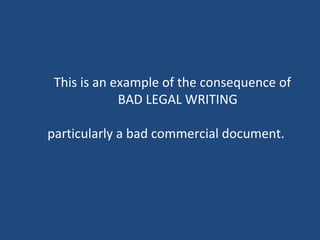How not to write (Legal Writing)
- 1. How NOT to write.
- 2. This is an example of the consequence of BAD LEGAL WRITING particularly a bad commercial document.
- 3. Mr. Landlord was the owner of a big parcel of land. He sold a portion located in the NorthWest corner of the lot to Mr. Middleman who in turn sold it to Mr. Buyer.
- 4. In the Deed of Absolute Sale from Landlord to Middleman, the wording was: ŌĆ£that NORTHERN PORTION ŌĆ”consisting of 100 m2ŌĆ” part of Tax Dec No. 22222 which is more particularly described as follows:ŌĆØ
- 5. The Deed of Absolute Sale then went on to describe the ORIGINAL lot as bounded: North : by ROAD East : by Lot East South : by Landlord ŌĆÖs lot West : by Lot West
- 6. You can already see the possible confusion that will result.
- 7. Mr. Middleman took the Deed and had the land registered under Tax Dec. No. 12345 in his name. BUT ŌĆ” the Tax Dec. contained the ff boundaries: North : by ROAD East : by Lot East South : by Landlord ŌĆÖs lot West : by Lot West
- 8. Middleman now found a buyer for the land and showed the Northwest corner. But failed to mention that it was ONLY the northwest corner that belongs to him.
- 9. Buyer checks the papers, sees that the documents refers to a big frontage and agrees to buy.
- 10. Buyer then drew up the Deed of Absolute Sale and proceeded to procure an Original Certificate of Title with the DENR.
- 11. After getting the OCT, Landlord now comes hopping mad and seeks the reversal of the sale, because what he sold was only the corner.
- 12. Landlord sues.
- 13. That could have been avoided IF the drafter of the first Deed of Absolute Sale was more specific.
- 14. For example: The phrase ŌĆ£NORTHERN PORTIONŌĆØ refers to the ENTIRE northern portion, not a part thereof.
- 15. Second: Aside from mentioning ŌĆśa portionŌĆØ or the ŌĆśNorthwest CornerŌĆÖ or something, It should have made mention of specific boundaries. E.g. The portion which has an existing fence .. Or something.
- 16. end
















